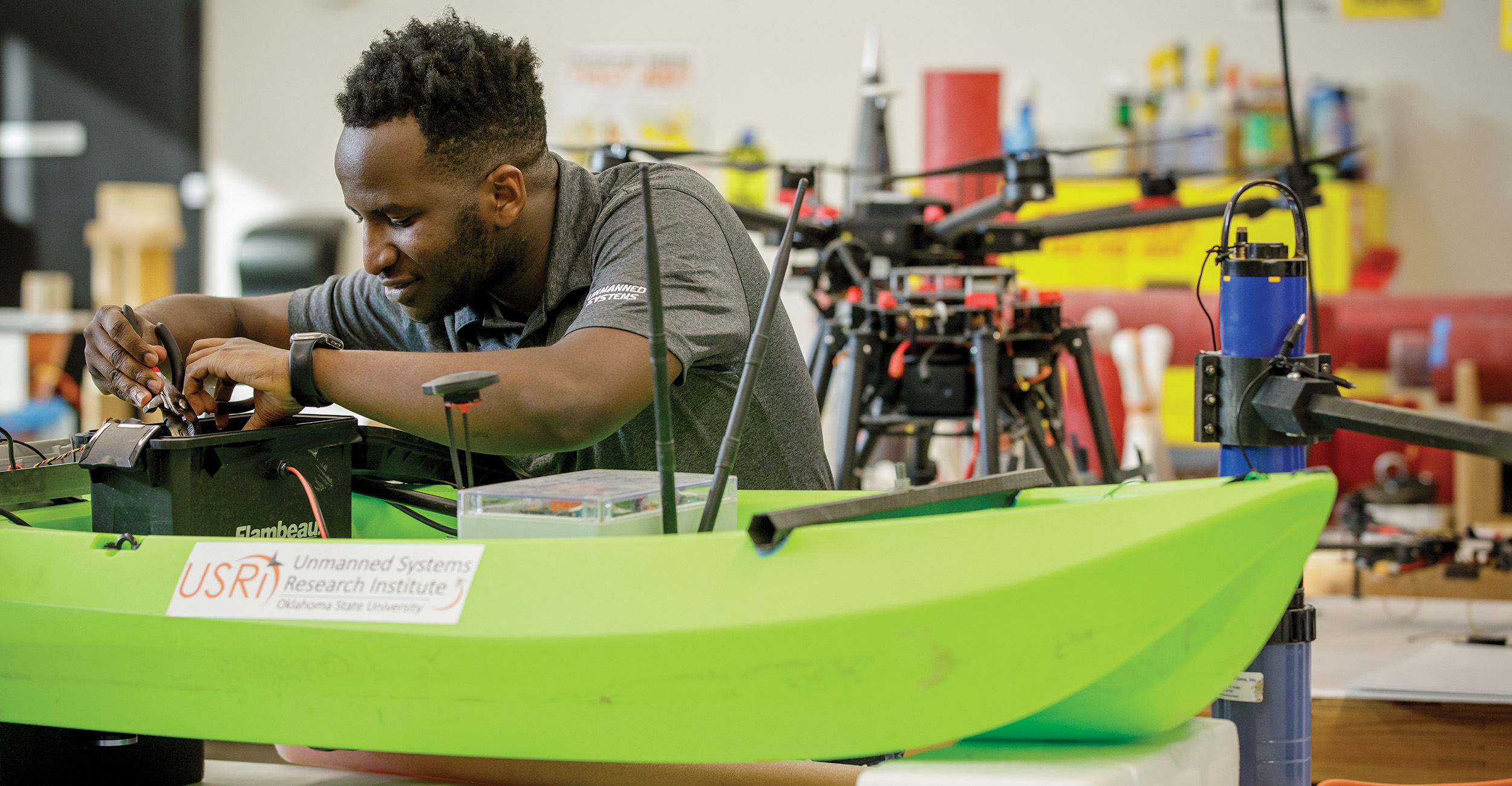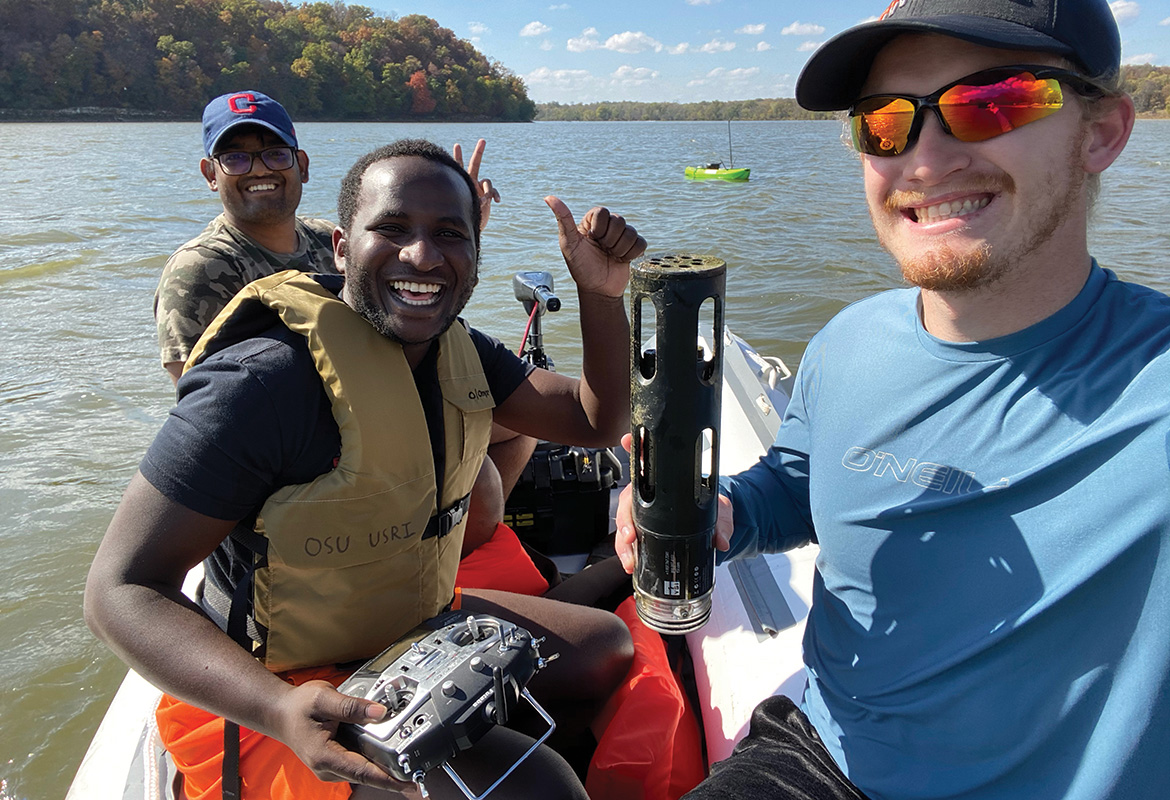
OSU researchers tackling problem of harmful algae blooms
Wednesday, April 27, 2022
Media Contact: Mack Burke | Editorial Coordinator | 405-744-5540 | editor@okstate.edu
Fresh water makes up just 3 percent of the world’s water supply. Only 0.5 percent of that is available for human use, according to the U.S. Bureau of Reclamation.
In lakes, ponds and rivers across the state and beyond, Harmful Algal Blooms, or HABs, can pose a risk to animals and humans, shut down recreational bodies of water and steal nutrients from other plants.
Ranging in color from green or blue to red or brown, HABs start from cyanobacteria, which can be found anywhere, said Andy Dzialowski, associate professor in the Department of Integrative Biology at Oklahoma State University.
“The cyanobacteria are already in the lake. And there’s some changing condition that promotes an increase in biovolume, and that causes a bloom,” Dzialowski said.
Researchers across campus are working on solutions to detect, prevent and even reclaim nutrients from these blooms.
A Boat with No Captain
Muwanika Jdiobe had never seen a plane up close — only the ones flying high overhead — before he boarded one bound for Oklahoma.
Jdiobe, who was born and raised in Uganda, was coming to OSU to join the aerospace engineering program.
“During the science fair at my high school, I was able to build a simple helicopter,” Jdiobe said. “It flew for maybe two seconds.”
With the threat of harmful algae blooms growing, OSU researchers are innovating new methods to tackle the problem
Although it was just two seconds, that experience was enough to spark his curiosity.
“I went to Google after that to find out what those people [who work on planes] are called. And I came to learn that they’re called aerospace engineers,” Jdiobe said. “And that’s when I said, ‘OK, I am going to become an aerospace engineer.’”
Jdiobe graduated as a Senior of Significance and Outstanding Senior in 2019 with a double major in aerospace engineering and mechanical engineering. He then pursued a master’s degree program in the School of Mechanical and Aerospace Engineering. That is when he got involved in researching HABs.
Dr. Jamey Jacob, head of OSU’s Unmanned Systems Research Institute, gave Jdiobe a challenge.
“He said, ‘I want you to come up with a solution of how we can monitor lakes autonomously,’” Jdiobe said. “And we have tremendous reasons why we would want to monitor lakes autonomously. It is cheap, it is safe and it is faster. It is an efficient way of doing work.”
The solution became known as MANUEL, an autonomous boat that monitors water quality including dissolved oxygen, pH, turbidity and nutrients, Jdiobe said.
“MANUEL measures water quality parameters using embedded sensor probes that are in direct contact with the water and the data collected is stored on board,” Jdiobe said. “Using digital maps and GPS, MANUEL can autonomously map an entire lake with no human intervention, even in conditions unsuitable for humans, such as high winds or storms.”

Jdiobe hopes his research can make a difference in the state and possibly worldwide, including his home country of Uganda.
“There are some parts of the world where people don’t know the water they are taking, whether it is safe for drinking, or the levels of pollution going into the water,” Jdiobe said. “So if these technologies further develop, it could be something we can use in different parts of the world, not just Oklahoma.”
Keeping an Eye on Lakes
OSU research teams are also monitoring algae in lakes across the state, such as Grand Lake in northeastern Oklahoma.
“We’ve done a lot of work in Grand Lake where they had a really large harmful algae bloom in 2011 that put Harmful Algal Blooms on the map,” Dzialowski said. “We’re using some water quality sensors, which basically can take data continuously at 15-minute intervals that we can put in the reservoir."
The team analyzes the data, looking for cues to better understand when blooms are starting to develop.
“There’s a thought that if you look at that data and look at the variability in the data, you might be able to get an advanced warning before a bloom starts,” Dzialowski said.
Dzialowski’s team also uses satellite and drone imagery to identify and monitor blooms.
“You can take an image from a satellite and in that image there is spectral data related to what’s in the water,” Dzialowski said. “If there’s a lot of algae, then the spectral signal is much different than if there’s not a lot of algae.”
This is helpful whether it’s as an early warning indicator or whether it’s as a system to identify where surface scums exist on the reservoir, because those surface scums can have toxin concentrations that are extremely elevated relative to the rest of the reservoir, Dzialowski said.
This research helps lake managers make better decisions to keep people and animals safe, Dzialowski said.
“If there is a sign that a bloom is beginning to develop 7-10 days in advance, is there something you can do in the reservoir to try and curtail the development of that bloom? I think ideally that’d be a great question to be able to answer,” Dzialowski said.
Photos by: Dr. Jamey Jacob
Story by: Harrison Hill | STATE Magazine
